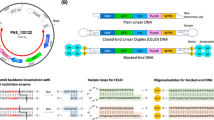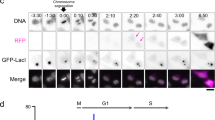Abstract
From an investigation of how transfected DNA navigates from the cell surface to the nucleus, we have developed a transfection method for primary human fibroblasts that approaches the efficiency of viruses. We have visually tracked the subcellular routing of exogenous DNA and find that all cells in an asynchronous population are surprisingly competent in the nuclear uptake of DNA, but two steps practically limit efficient transfection to a minority of cells. First, regardless of the method used to traverse the cell membrane – CaPO4 precipitation, lipofection or electroporation – it appears that nuclear transport of DNA requires routing through endosomes and lysosomes. Apparent abrogation of endosome–lysosome fusion or translocation with microfilament or microtubule toxins, respectively, inhibits the nuclear accumulation of transfected DNA, but interruption of lysosomal function with protease inhibitors promotes it. Second, in normal human fibroblasts, which are refractory to transfection, the exogenous DNA is rapidly excluded from the nucleus, but in HeLa cells, which are readily transfected, there is prolonged nuclear stability of the DNA, indicating the failure in HeLa cells of a mechanism for the elimination of foreign DNA. These observations imply strategies for optimizing gene transfer efficiency in virus-independent approaches to gene therapy.
Similar content being viewed by others
Author information
Authors and Affiliations
Rights and permissions
About this article
Cite this article
Coonrod, A., Li, FQ. & Horwitz, M. On the mechanism of DNA transfection: efficient gene transfer without viruses. Gene Ther 4, 1313–1321 (1997). https://doi.org/10.1038/sj.gt.3300536
Received:
Accepted:
Issue Date:
DOI: https://doi.org/10.1038/sj.gt.3300536
- Springer Nature Limited
Keywords
This article is cited by
-
In-vivo transfection of the proopiomelanocortin gene, precursor of endogenous endorphin, by use of radial shock waves alleviates neuropathic pain
Journal of Orthopaedic Science (2013)
-
Stable transformation and cloning mediated by piggyBac vector and RNA interference knockdown of Drosophila ovarian cell line
In Vitro Cellular & Developmental Biology - Animal (2011)
-
Efficient transfection method using deacylated polyethylenimine-coated magnetic nanoparticles
Journal of Artificial Organs (2011)
-
Release of Plasmid DNA-Encoding IL-10 from PLGA Microparticles Facilitates Long-Term Reversal of Neuropathic Pain Following a Single Intrathecal Administration
Pharmaceutical Research (2010)
-
Tracking the pathway of calcium phosphate/DNA nanoparticles during cell transfection by incorporation of red-fluorescing tetramethylrhodamine isothiocyanate–bovine serum albumin into these nanoparticles
JBIC Journal of Biological Inorganic Chemistry (2007)




